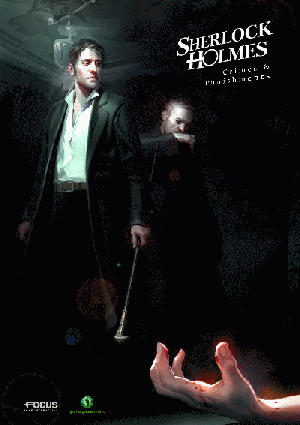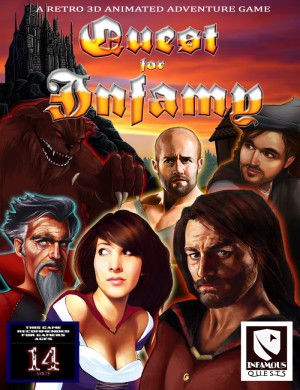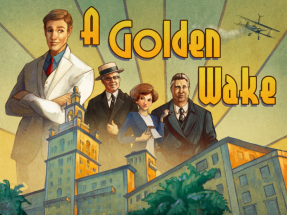Review for Sherlock Holmes: Crimes & Punishments

Game information
Adventure Gamers Awards
In my mind, 2012's The Testament of Sherlock Holmes was Frogwares’ finest hour in their long history with the Great Detective, so they now have their work cut out trying to match it. But the Ukrainian developers have never been ones to shy away from reinventing their games, and in Crimes & Punishments they’ve taken a radically different approach from those that preceded it. This time around, not only have they overhauled the game engine (again), they’ve overhauled the very nature of their successful sleuthing franchise. The changes are numerous: gone are the tricky brainteasers and traditional point-and-click adventuring, and in their place we have a more narrative- and investigation-based adventure à la L.A. Noire or The Walking Dead. The result is another entertaining offering that for the most part addresses the small issues with Testament, but in so doing creates some new ones that haven’t been seen before.
Instead of just one story to play through, Crimes & Punishments is presented as six separate cases with only a token storyline running throughout to vaguely tie them together. In fact, if you didn’t know better you’d swear this game had been released episodically. Yet after firing up the first case, even with all the changes you’ll find yourself on very familiar ground: namely Baker Street. The mystery kicks off with the sound of gunfire and, assuming the role of Watson, you’ll need to manoeuvre your way to Sherlock at the front of the room, who seems intent on shooting you. For any fan of the recent Sherlock revivals, this won’t be cause for alarm, as Holmes is merely testing himself with a blindfold on. This is one of several nods to the new adaptations, including more bombastic opening credits, which aim to appeal to newer players.
What’s immediately obvious in this opening scenario is the upgrade in presentation. Crimes & Punishments is an extremely slick package. The real-time 3D graphics have had a major upgrade even from Testament, which was already an impressive looking adventure. Improvements come from enhanced shading around objects and vastly improved facial animations, meaning the characters’ lips finally sync with what they’re saying. The level of detail in the environments is exemplary; from a recreation of Kew Gardens (complete with buzzing insects) to a Victorian circus and a gorgeous Japanese villa, all the way to the last case in a murky backstreet, the locales have never looked better. Characters also look more realistic, complete with wrinkles, skin blotches and moles. Within cutscenes the animations are impressively lifelike – I can imagine an awful lot of motion capture was used – and whilst the in-game animations aren’t quite as good (doors open by themselves, with no animation of Sherlock opening them), this is a minor niggle in an otherwise flawless appearance.
I was critical of Testament’s sound design as one of the weaker points of that game. Thankfully Frogwares have put a great deal of effort into this aspect. Whereas before the dialogue often felt stilted, here the voice-overs are consistently strong, not only from the leads but the supporting characters too. Dialogue flows naturally between characters, and even Watson is less prone to strange intonation than he was previously. Similarly, the music, whilst still the same piano and string arrangements, is now used to better effect, punching dramatic moments and enhancing the atmosphere of certain scenes. These weaknesses seemed like small gripes in the previous game, but seeing (or rather, hearing) them rectified here shows what a difference it can make to the overall polish.
If Testament focused on not knowing Sherlock’s motives, Crimes & Punishments is the antithesis. This time around, the gameplay is wholly focussed on what the player can deduce using Sherlock’s keen observations and insights. Where earlier games went heavy on the puzzle-solving, this game emphasises investigation and deduction. As a result, many of the game mechanics have been adjusted accordingly. You’ll still be controlling Sherlock with the mouse and keyboard (or gamepad), and there’s still the option of controlling him from a first- or third-person perspective, but there’s sadly no point-and-click mode this time, and you won’t be picking up items to use. Instead, you’ll spend most of your time interrogating suspects and pawing over crime scenes.
You can move freely within each location, but there are now no complicated interaction options. If Sherlock walks near something that he can do something with, you’ll usually only get one option, which you select by left-clicking (usually examine or talk). These interactions are clearly signposted by, for want of a better word, “flags” appearing above the item, making it very difficult to miss anything. This streamlining of Frogwares’ usual format to make things snappier and slicker extends to the conversations as well: dialogue options include just a couple of lines, although there are few red herrings. Also, examining everything in a given scene will usually trigger a new cutscene or a monologue from Sherlock of where he should go next.
Each case opens with a particular event that Sherlock must investigate, the first being the murder of a retired whale hunter who died under mysterious circumstances at his quaint cottage in Sussex. Sherlock can travel to various key locations from the outset, like Baker Street and Scotland Yard, with other areas being added as the investigation requires. Travel is handled through a map, with a simple left-click on a location initiating a cab journey to it. This is a nice sequence that, whilst clearly hiding a loading screen, also allows you to open Sherlock’s journal and assess the clues and testimonies you’ve received so far.
As you arrive at the first murder scene, you’ll be introduced to the various new gameplay mechanics. The first is Sherlock Vision, in which the screen turns monochrome and anything unusual – that only the brilliant Holmes could see – is highlighted in orange. The effect is similar to the inspection mode in games like Heavy Rain or Arkham Asylum. Moving nearer to the highlighted area allows Sherlock to examine it in more detail. Whilst this ability is new to the series, it ultimately only leads to close-ups of such things as footprints, shelves, desk drawers and books, similar to how previous games worked already, allowing you to measure things or use a magnifying glass to look for unusual items.
Another addition to Sherlock’s powers of deduction is the Imagination Mode. This allows Holmes to add ghost images to the scene, conjured up from his imagination, that help piece together the previous events that happened there, whether it’s missing items he knows should have been present or missing parties’ movements before the events. This is something new to the series, and is used to great success when trying to imagine the sequence of events that led up to the murder. Much like in The Vanishing of Ethan Carter, you’ll see several ghost images that you must number in the correct order to build up a picture of what has occurred.
Both features act as immersive elements more than anything else, as they put players inside the brain of Sherlock, seeing things from his perspective. They're also an excuse for the developers to add in small subtitles to the environment, in keeping with the recent TV adaptations. An icon appears in the top right hand corner of the screen if there’s something that can only be seen in either mode, so there’s no fear of overlooking anything.
There are other methods Sherlock uses over the course of his investigations, some of which are the closest this game gets to traditional puzzles, whilst others are minigames. They’re too numerous to mention them all and you won’t find anything challenging here, but highlights include piecing together an image in Sherlock’s head of what a smell might be, or skewering a pig to ascertain if a weak man could throw a harpoon. You’ll even need to disguise Sherlock on several occasions to make sure he has the right outfit for the job. Locks form a sort of tumbler puzzle where you must match the sections together, and you’ll even need to hammer at the left mouse button to beat a guy at arm wrestling. Some are better than others, but they aren’t used repeatedly, aside from the lockpick puzzle, so if you find one unappealing you’ll likely not encounter it again. They do, however, add up to give a nice variety to the methods with which you can get to the bottom of each case.
The majority of the game, however, plays out in a traditional detective style. You’ll scour a crime scene for every shred of evidence, then use what you’ve found to either piece together a conclusion or press a witness for more information relating to it. Conversations are handled either with witnesses at the scene or with suspects at Scotland Yard. During dialogue, the scene moves to a close-up of your counterpart’s face, and Sherlock has several lines of enquiry to choose from, selectable at the bottom.
An additional option during conversations is Sherlock’s ability to profile the person he’s speaking with. Selecting a small portrait icon causes time to slow down, allowing you to closely examine the person. During this time you can sweep the screen with the mouse looking for hotspots that reveal something about that character. These can include things like smart clothing revealing the person came from wealth, or red hands signifying a manual worker. The available observations are greyed out to the side so you know how many you need to find. None are particularly taxing; they’re just a fun addition to conversations. When you’ve completed your profile, you can use the information you’ve gleaned against the person if you suspect them of lying during normal conversation. At certain points, after a lie, a Quick Time Event will occur where if you’re fast enough you can present a piece of evidence that contradicts what they’ve just said.
Finally, no good detective would be complete without his trusty library and lab. Whilst there’s no inventory, you will still collect certain items and articles. There’s no guesswork required with any of these items and you won’t “use” them in the traditional sense. Instead they’ll be added to Sherlock’s journal with a tool tip next to them telling you what to do with them. As in previous games, scientific testing and library research happens back at 221B Baker Street, so upon returning there you’ll find a new option when looking at the desk or books. The scientific testing happens in a similar way to previous games, mixing solutions together to get a reaction, or scraping away at items to reveal what’s underneath. These sequences don’t happen often, however, and are skippable when they do occur. Overall, the difficulty is extremely low – only one puzzle involving a set of blocks was at all taxing for me, and this was more the interface proving unwieldy than the difficulty of the actual puzzle.
All these clues and witness testimonials are stored in Sherlock’s journal, and any conclusions he can draw from them are written out in the deduction space. This is similar to the mechanics used in previous games, but this time around the idea is that you are piecing together the puzzle in Sherlock’s head, a point emphasised by the deduction space resembling brain cells being linked together to form a hypothesis. Unlike in earlier games, several deductions can now be formed, pointing to different characters as culprits. It is wholly possible right from the first case to point the finger at the wrong person. After your accusation, you’re presented with a short cutscene of Sherlock confronting the suspected perp before a summary screen runs you through how many clues you found and the option of revealing if your guess was right or not.
There are multiple endings for each case, allowing for varying degrees of success, but there is always a correct culprit. It’s not always clear how all the clues add up to this solution, however, as certain things seem to be added to the deduction space with no clear explanation of how they relate. There are no penalties for incorrect guessing, and you will move on regardless of who you pick, but you can replay the ending with a different accusation if you want to try again. You can also choose how lenient you should be in condemning the guilty party (or at least, those you accuse of being guilty). Picking your culprit gives you two options: either throwing the book at them or letting them off gently.
The deduction mechanic gives a lot of freedom to players in the choices they make, which fits with the way recent adventure games have been going, in that the experience is less about puzzles and more about choices. But it isn’t executed quite as successfully here as in a game like The Walking Dead. Choices don’t carry over to the next case (aside from a letter arriving, thanking Holmes for his hard work), so there are no lasting effects, and it can often feel frustrating when the game doesn’t properly explain why the real culprit is the correct one. On case three in particular, I felt I was just guessing who was guilty without a proper amount of information, and even after I made my choice (the wrong one to begin with, then redone to pick the right one) I found quite a few red herrings that didn’t tally up with what the game said was the right answer. There’s no flashback displaying the events that led to the murder, as you’d expect in a whodunnit, so I was left hanging.
In terms of story, however, the six cases are excellent, with a nice variety throughout. Frogwares’ Sherlock Holmes games have always managed to tell a good story, but this is the first time any have been based on Sir Arthur Conan Doyle’s own work, as several of these cases are. Each murder plays out in a different manner with its own certain hook: a missing murder weapon or a simple theft hiding darker secrets, for example. I particularly enjoyed the case in Kew Gardens and a vanishing train case, both for their beautiful scenery and for their novel approach. Whilst a couple felt significantly shorter than the others, I found all six enjoyable, though there’s no temptation to revisit them again. As long as you find all the available clues, you can’t really experience a case differently by replaying it, so you will only get a different outcome if you make a different choice right at the end.
One element of the storytelling does let the game down, however. The overarching plot adds very little to the proceedings, seemingly shoehorned into the final half hour with only a few name drops from the beginning to link back to. This feels like little more than a token gesture to connect the disparate cases together. It’s disappointing, since I found the overall story arc in Testament to be its strongest point.
The level of hand-holding in this game really sets it far apart from its predecessors. You’ll never be stuck, since this is not the direction Frogwares wanted to go. Rather, you’ll play through with icons telling you when there’s something to examine, a journal telling you where you need to be, and little to no challenge in the crime scene investigations. This is fine if you have a strong moral story to tell, but I don’t see Sherlock Holmes as a franchise with much to offer in terms of moral choices – he is first and foremost a detective who wants to get to the bottom of events, so offering players the opportunity to accuse the wrong person just jarred for me as being particularly out of character. So whilst Crimes & Punishments is enjoyable to play through, I missed the previous games’ approach of blending brainteasers and inventory puzzles with their mystery-based storytelling.
All in all, though, this is an excellent package and one that will appeal to most adventure gamers, whether they’re familiar with the rest of the series or not. At roughly 15 hours of gameplay, this is every inch the premium adventure and it should serve Frogwares very well in bringing new fans to the franchise. I had an awful lot of fun playing it, even if I prefer the slightly more challenging Sherlocks of old. The wide variety of game mechanics and multiple ending options make the mysteries sufficiently thrilling, and the deduction space is a satisfying way to solve a case through Sherlock’s eyes, though one always imagines it a trickier affair than this game would have you believe. Even with its streamlined simplicity, however, Sherlock Holmes: Crimes & Punishmentsis a good fun game that I highly recommend. It’s a triumph of style, if a little light on substance, but if this is to be the new direction for Sherlock, the game is well and truly afoot for more.
WHERE CAN I DOWNLOAD Sherlock Holmes: Crimes & Punishments
Sherlock Holmes: Crimes & Punishments is available at:
We get a small commission from any game you buy through these links (except Steam).Our Verdict:
Sherlock has never looked better, and Crimes & Punishments is an enjoyable anthology that should bring in new fans, but there’s little challenge for a seasoned adventurer.






























